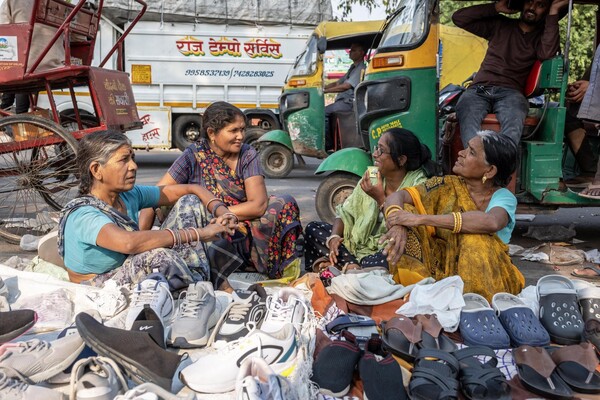
Griffin Pitt, right, works with two other student researchers to test the conductivity, total dissolved solids, salinity, and temperature of water below a sand dam in Kenya.
(Image: Courtesy of Griffin Pitt)
Like many people, University of Pennsylvania senior Melanie Murphy uses her smartphone to do a Google search when she’s looking for information, but, now that she knows about the environmental impact of using electronic devices, she thinks twice before doing so.
This semester, while taking the “Environmental Media” cinema studies class in the School of Arts & Sciences, Murphy learned that using electronic devices can cause harmful carbon emissions.
The class taught by Rahul Mukherjee, the Dick Wolf Assistant Professor of Television and New Media Studies, looks at how these types of data-driven activities affect the earth’s geology and ecosystems. It also explores the media’s depiction of environmental issues and controversies involving media infrastructures, such as cellphone towers and the possible effects on the health of nearby residents.
Mukherjee says many people aren’t aware that their appetites for data via computers, cellphones and other electronic devices have environmental implications.
“Think about the carbon footprint of a Facebook ‘like’ or binging on NetFlix,” says Mukherjee. “Cloud computing is not soot free.”
Millions of gallons of water and huge amounts of electricity are used by companies each year for air conditioning systems to cool data servers.
“It requires a significant amount of coal that’s burned,” says Mukherjee. “Sometimes it’s alternative fuels, and sometimes it’s nuclear. In a number of cases it can be fossil fuels that are used to power these servers.”
The topic has sparked conversations in class.
“Even though I’m still searching at the same frequency that I usually do, there’s always a tiny thing in the back of my head now that this search is causing an amount of detriment to the environment,” says senior Justin Chang, a mechanical engineering and applied mechanics major from Cupertino, Calif. “I guess it’s like a delayed, ‘Oh snap,’ moment that the search that I made just caused carbon emissions.”
As Murphy was about to share the details of how much energy is required to conduct a Google search, she thought for a moment, but couldn’t remember all of the facts, so she Googled it.
An earth science major from Philadelphia, Murphy found that the amount of energy used for a Google search is the equivalent of turning on a 60-watt light bulb for 17 seconds or causing .2 grams of carbon emissions.
Murphy says, “It was a mind trippy thing to think, ‘Let me find this fact that I’d like to share, but I need to conduct a Google search to find out how much energy I’m going to be expending for this Google search.’”
According to Mukherjee, recognizing individual responsibility for environmental destruction is necessary, but structural changes are needed as well.
He says, “Governmental regulation, policies guiding energy firms and tech companies have to be studied as we look at social media’s role in environmental pollution. Google has been working towards making the process of cooling servers efficient, but questions of justice and resource distribution remain.”
During class students also analyze the media’s presentation of disasters such as Hurricane Katrina and the Fukushima meltdown to consider whether what’s being presented is sensationalized or if the experts who offer their views can be trusted.
“It’s an interesting debate between should we just hear the experts and should we just care about what their arguments are,” says Mukherjee. “Should we listen to people who are being affected, who have toxins in their bodies and what the toxins are doing to them?”
Mukherjee’s interest in the environment and the media began as an undergraduate in India when he read the book Advocacy After Bhopal by Kim Fortun.
After learning details of the 1984 explosion of the Union Carbide chemical plant in India, Mukherjee began studying how public protests by survivors highlighted the effect of toxins on their bodies.
As a Ph.D. candidate in film and media studies at the University of California, Santa Barbara, Mukherjee studied four environmental controversies in India, and how the media covered the issues. Bhopal was one of the cases. He also examined concerns about nuclear reactors and radiation exposure, the issue of genetically modified vegetables and radiation from cellphone towers.
“Cell antennas emit non-ionizing electromagnetic radiation,” says Mukherjee. “For people who live close to cell antennas, the argument by some scientists and some concerned citizens who live close to cell towers is that continuing and chronic exposure to cell antenna signals could lead to cancer.”
The “Environmental Media” class, offered for the first time this semester, combines Mukherjee’s interests in environmental issues and cinema studies.
“The really emotionally charged testimonies can move people and can mobilize protests and environmental movements,” he says.
While the students in the class say they aren’t planning to make major changes to their use of electronic devices, the thought-provoking topics covered have inspired them to consider actions they can take to protect the planet in a small way.
“Maybe when I’m writing a paper, instead of searching thesaurus.com or dictionary.com for every word I need,” says Murphy, “I could pull out a real dictionary or thesaurus.”
Jeanne Leong

Griffin Pitt, right, works with two other student researchers to test the conductivity, total dissolved solids, salinity, and temperature of water below a sand dam in Kenya.
(Image: Courtesy of Griffin Pitt)

Image: Andriy Onufriyenko via Getty Images

Four women street vendors sell shoes and footwear on a Delhi street.
(Image: Kannagi Khanna)

nocred